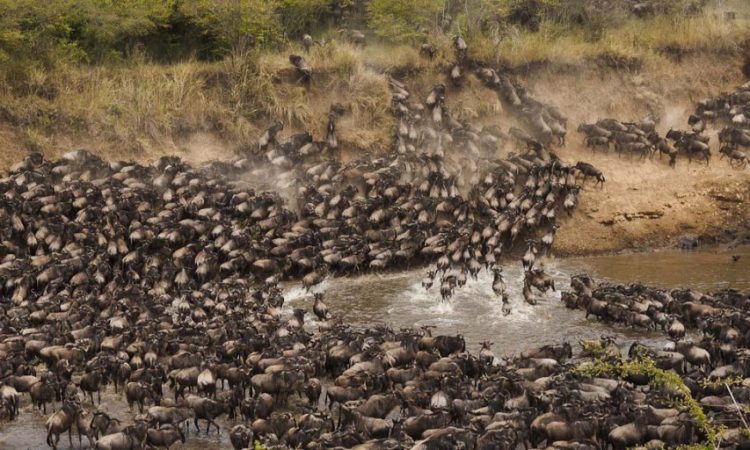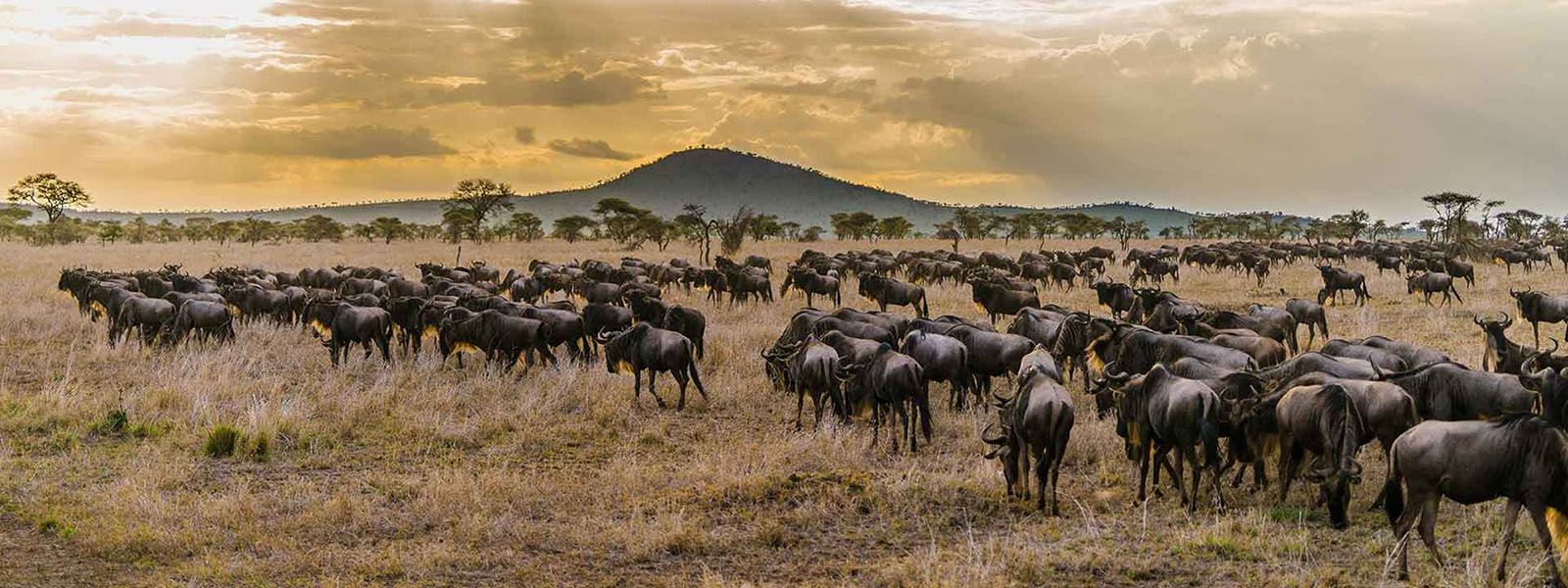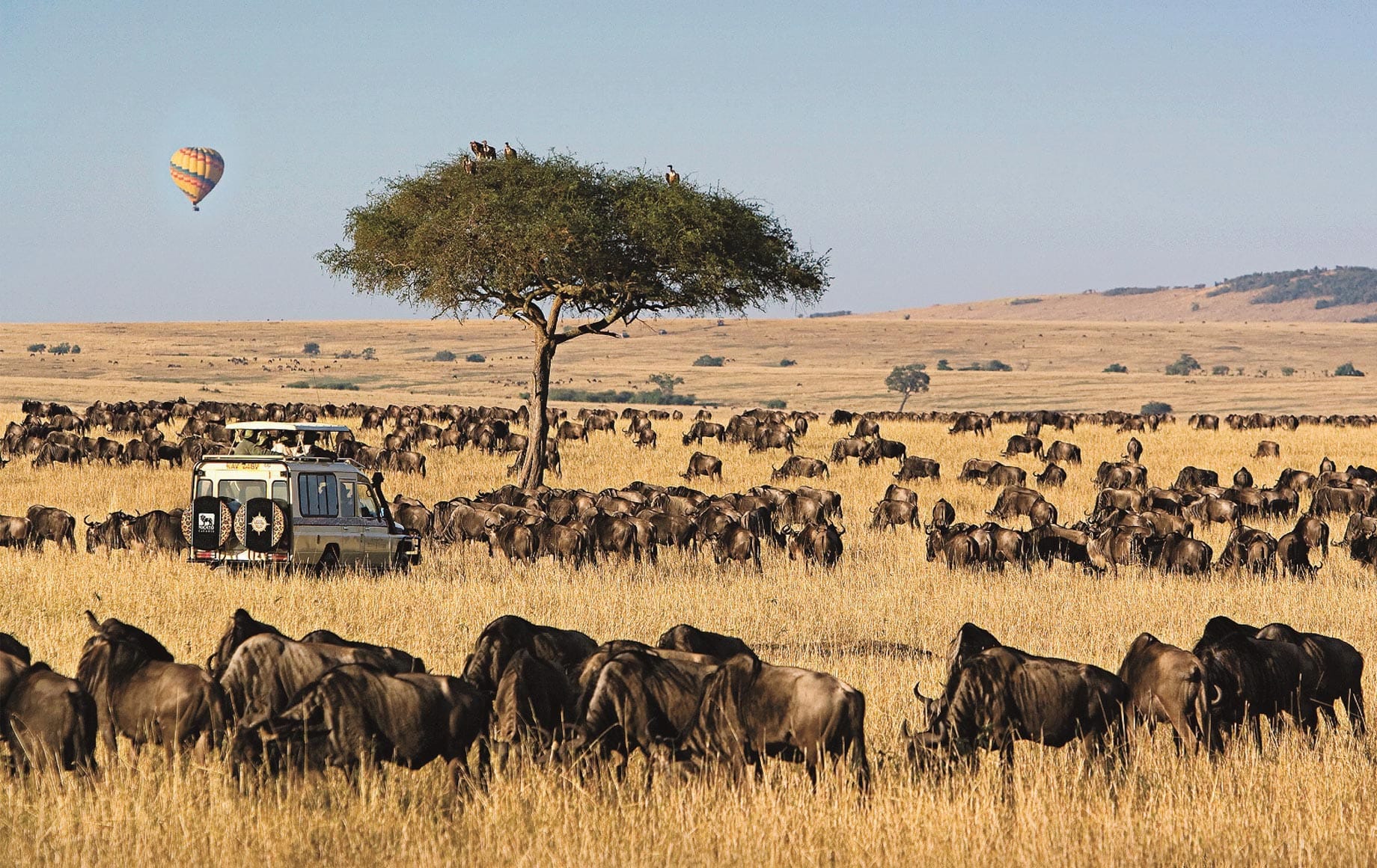Masai Mara National Reserve Wildebeest Migration Kenya is the greatest wildlife traveling roadshow on earth that shall literally blow your mind away. What is the wildebeest migration? The great wildebeest migration is the movement of over 2 million wildebeests along with other grazers through the Serengeti-Masai Mara ecosystem in their quest for among others, greener pastures. As the saying goes that “the grass is always greener on the other side”, the wildebeests along with hundreds of grazers like zebras and gazelles migrate in large numbers to the other side, in the Serengeti or Masai Mara, where the grass is greener and can thus sustain them for a period of time. Over 2 million wildebeests, gazelles, zebras, and other herbivores move through the Serengeti National Park Tanzania throughout the year in cycles, as they make their way to the Masai Mara National Reserve Kenya. The great wildebeest migration is known as one of the most iconic and spectacular shows in the world, which is a must-see by every traveler.

The Masai Mara National Reserve wildebeest migration is a constant year-long movement of great iconic and natural phenomenon whose timing utterly depends on environmental factors, weather and the animals migrating themselves. While the animals during the great wildebeest migration spend most of their time in Serengeti National park Tanzania, they also get to spend several months in the amazingly stunning plains of the Masai Mara National Reserve Kenya.

As the large herds of wildebeests and other grazers move in a frenzy in what is termed as one of the greatest world spectacles, through the Mara River crossing to Masai Mara National Reserve Kenya, they are met by a good share of obstacles including the very lethal predators like lions, leopards at the river banks while the huge crocodiles lie in wait in the river waters devouring all that they can as the herds make their trek to the Masai Mara. Watching the large herds of the wildebeest migration jumping in a frenzy from the riverbank edges into the waters, trying with all might to make it to the other side is indeed the true definition of the survival of the fittest. The surviving herds of wildebeests are rewarded with the spoils of the wide and green pastures of the Masai Mara. The Masai Mara National Reserve wildebeest migration, which travelers get to watch as the herds make their way to the reserve through the fierce Mara River, is a spectacle to watch. Life is good for a while in Masai Mara National Reserve, before the herds dwindle all there is to eat here that they think of moving yet again, back to the Serengeti.
Best Time to See the Masai Mara National Reserve Wildebeest Migration
Generally, the best time to see the great wildebeest migration in Masai Mara National Reserve Kenya is from the months of July to October. Given that the Great Wildebeest Migration is a purely natural phenomenon however, the exact dates are not guaranteed. All we can do is give a general outline of the probable times to expect the herds. The weather can be unpredictable and the rains can come early or late, thus affecting the movement of the herds of the great wildebeest migration bringing them early or late. The time when the Masai Mara National Reserve wildebeest migration is expected also doubles as the best time to visit Masai Mara National Reserve for wild game viewing which is abundant. If you move the wildebeest migration therefore on your booked Masai Mara National Reserve safari dates, you shall definitely be rewarded with some of the most amazing and unforgettable game drives to see a variety of wildlife in Masai Mara National Reserve Kenya, including the big 5 animals. To maximise your chances of witnessing the Masai Mara National Reserve wildebeest migration, spending more time in the park is best recommended to give you more chances of witnessing one of the greatest wildlife spectacles and nature show in the world.
Here is what you should expect in the Masai Mara National Reserve wildebeest migration for the time it is expected to be here;
July
From late July and into August, the wildebeest migration herds leave the now arid plains of the Serengeti National Park Tanzania in search for food and water, thus opting to move northwards, through the Mara River to Masai Mra National Reserve. This is the best time to watch the dramatic and iconic Mara River crossings. Watch the predators, too, at their wildest.
August
By this time, most part of the herds of the wildebeest migration shall have made it to the Masai Mara National Reserve Kenya. These are the champions, the survivors of one of the fiercest movements in the world.
September
The herds of the Masai Mara National Reserve wildebeest migration have time of their life here in the plains of the Masai Mara National Reserve, enjoying the peace and quiet, and plentiful food. This is the best time to enjoy epic safari game drives in Masai Mara National Reserve Kenya.

October
The Masai Mara National Reserve Kenya wildebeest migration in the month of October sees the rains starting and by November you see the herds heading back to the Serengeti following the beginning of rains. The cycle yet gain repeats.
Witnessing the Masai Mara National Reserve wildebeest migration is one of the most fascinating things to see, whilst in a Kenya safari tour. Reach out to a trusted tour operator to help you create one of the most amazing and unforgettable Masai Mara National Reserve wildebeest migration safaris, and be blown away by the beauty and nature at play.


